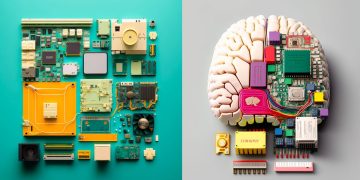Introduction
Digitalization has drastically changed how we live and work. From communication tools to advanced technologies like artificial intelligence (AI) and automation, digital tools have become integral parts of our professional lives. They promise to increase work efficiency by streamlining tasks, improving productivity, and enabling easier collaboration. But while these tools have undeniable benefits, we must ask: Can digitalization truly enhance our work efficiency?
As digital technologies become more embedded in the workplace, it’s important to consider whether the changes are helping employees and businesses operate more efficiently or just adding layers of complexity. Digital tools may help automate mundane tasks, but they also introduce new challenges such as managing information overload or balancing remote work with personal life. This article will explore both the positive impacts and the challenges digitalization brings to work efficiency, helping us understand if it truly lives up to its promises.
1. What Does Digitalization Mean for Work Efficiency?
Before diving into whether digitalization improves efficiency, we need to define what it means in the context of modern work. Digitalization refers to the use of technology to enhance business processes and work environments. This includes the use of cloud services, AI, automation, and data analytics, among others. These technologies aim to streamline workflows, enhance communication, and reduce the time spent on routine, repetitive tasks.
At its core, digitalization is about leveraging technology to save time, reduce costs, and increase productivity. For example, AI can help businesses analyze data faster than ever, while cloud computing allows employees to access documents and collaborate from anywhere in the world.
2. The Benefits of Digitalization for Work Efficiency
A. Time-Saving Automation
One of the main promises of digitalization is time-saving. Automating repetitive tasks like data entry, scheduling, and customer service allows employees to focus on more complex and creative work. With the help of AI and robotic process automation (RPA), businesses can reduce the time spent on menial tasks, freeing up valuable hours for strategic thinking and innovation.
B. Improved Collaboration and Communication
Digital tools like project management platforms (e.g., Asana, Trello), video conferencing (e.g., Zoom), and cloud-based file sharing (e.g., Google Drive, Microsoft OneDrive) have made collaboration faster and more efficient. Employees can work together in real-time regardless of location, making it easier to manage projects and keep teams aligned. This is especially important for remote and hybrid work environments.
C. Enhanced Decision-Making with Data Analytics
In the digital age, companies have access to more data than ever before. Tools like big data analytics and machine learning enable businesses to gather insights from vast amounts of data, helping them make more informed decisions. By using data to drive strategies, companies can optimize processes, target the right customers, and predict market trends.
D. The Flexibility of Remote Work
Cloud computing has made remote work more feasible than ever. Teams can access files, communicate with colleagues, and work from anywhere, allowing for greater flexibility in work hours and location. For many, this flexibility contributes to a better work-life balance, which can enhance overall productivity.
3. Challenges and Drawbacks of Digitalization
A. Overwhelming Information and Complexity
While digitalization brings many advantages, it can also lead to information overload. The abundance of tools, platforms, and data can be overwhelming, especially for employees who are not tech-savvy. Juggling multiple digital tools can create unnecessary complexity and reduce efficiency instead of enhancing it.
B. Resistance to Change
Not all employees embrace digital transformation. Some may resist using new tools due to unfamiliarity or a fear of job displacement. In workplaces where digital tools are implemented without proper training or support, employees may struggle to use them effectively, leading to frustration and decreased productivity.
C. Digital Fatigue and Burnout
The constant use of digital devices can lead to digital fatigue. Employees who are always “on,” responding to emails, participating in virtual meetings, and managing tasks online, can experience burnout. The pressure to be constantly connected can diminish both mental and physical well-being, which in turn impacts work efficiency.
D. Security Concerns
With the rise of digital tools comes the increase in cybersecurity risks. Sensitive data and company information are more vulnerable to hacking, phishing attacks, and other threats. Companies need to invest in strong cybersecurity measures to protect their assets and maintain employee trust.

4. Impact on Work-Life Balance
One of the key factors to consider in the digitalization of work is how it impacts work-life balance. Remote work, for example, offers the flexibility to work from home but can blur the boundaries between personal and professional life. This can lead to employees feeling like they are always on the clock, even when they are not technically working. In such a scenario, digital tools meant to enhance productivity can ironically contribute to stress and burnout if not managed properly.
On the other hand, digitalization can also provide more control over work schedules. Employees who use time-management tools and collaborate via digital platforms can set their own hours, which might result in a better work-life balance. However, this balance depends largely on individual and organizational approaches to digital tools and remote work policies.
5. The Role of Digitalization in Shaping the Future of Work
As we look ahead, it’s clear that digitalization will continue to shape the future of work. However, the real question is whether it will enhance work efficiency for everyone or create new challenges. The success of digital tools will depend on factors like company culture, employee training, and the thoughtful integration of technology into daily workflows.
To truly benefit from digitalization, companies must strike a balance between innovation and maintaining a healthy work environment. This includes fostering digital literacy among employees, setting clear boundaries for remote work, and investing in tools that simplify rather than complicate tasks.
Conclusion
Digitalization has the potential to significantly improve work efficiency, but its success depends on how it’s implemented and embraced within a workplace. While it offers clear advantages, such as time-saving automation, better collaboration, and data-driven decision-making, it also introduces challenges like information overload, resistance to change, and digital fatigue. For digitalization to truly enhance work efficiency, companies need to focus on integrating the right technologies, offering proper training, and supporting their employees in adapting to new ways of working. Only then can we fully unlock the potential of digital tools and achieve a more efficient, productive, and balanced work life.
















































Discussion about this post